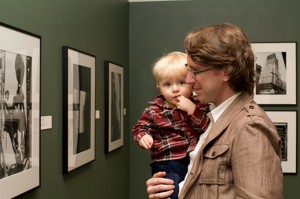Amid the soaring city skylines depicted in gradients of grays, blacks and whites, the limbs of construction workers parallel the lines of the majestic building they are working on, the Empire State Building. The most striking part of the photograph, however, is not the architecture but its human counterparts — the workers.

The Handwerker Gallery is currently showing “The Rise of a Landmark: Lewis Hine and the Empire State Building,” as organized by the George Eastman House. Comprised of silver gelatin prints documenting the construction of the Empire State Building and the workers who created it, Hine’s photographs speak more to the human spirit than to the building’s impressive physical stature.
Photos like “Icarus Atop Empire State Building, 1931” demonstrate the resilience and tenacity of workers, risking their lives to build the Empire State Building. The photo depicts an unnamed man named Icarus — a reference the son of the master craftsman in Greek mythology, suspended high above the New York City skyline, hanging tenuously from a cable. His figure, clad in overalls, complete with windblown hair and cap, is far more prominent than the skyscrapers in the background. The breathtaking image is even more intriguing when the observer considers the great danger that the worker and Hine himself faced working at these heights with little security.
Another striking image is “Man on Girders, Mooring Mast, Empire State Building, 1931.” The photograph effectively frames a worker within the skeleton of the building. His back turned to the camera, he straddles the framework and surveys the overwhelming panorama of the city at the dizzying height of the building. The background of buildings fades cloudily against the dark and precise lines of the metal framework, further emphasizing the disproportionally large figure of the worker in relation to the skyscrapers.
The black and white tones of the prints also help to stress the emotion and personality of the subjects. Without the distraction of color, the rich variation of the tones and the focus of the photographs are highlighted distinctly, giving a raw, more sincere look to the prints.
Hine’s images consist mostly of the actual construction of the building and of those responsible for its creation. This works to his benefit, as the photographs of the workers are the strongest, revealing human strength and dignity amid the changing face of American society.
His collection is also a love letter to New York City. One of the final pieces in the collection particularly embodies this sentiment. “Night View of City and Empire State Building, 1931” features a myriad of twinkling lights peeping out of skyscrapers, overexposed and blown out of proportion against the dark cityscape and misty skies. This image truly captures the mystery and magic of the city that doesn’t sleep.
The entire collection also demonstrates the growth of industrialism and the rise of modern technology, flourishing despite the Great Depression. Smudgy outlines of urban buildings, the skeletal construction of the Empire State Building and the looming prominence of the Rockefeller tower in the distance all enhance the homage to New York that this collection expresses. The distinctly Art Deco design of the Empire State Building also provides an unexpected juxtaposition to the hardy and rugged workers creating it.
The collection offers an introspective and intensely personal look at the construction of one of the world’s most famous buildings. These prints reach beyond the sheer enormity and grandeur of the building to create portraits of the people who built it.
“The Rise of a Landmark: Lewis Hine and the Empire State Building” is on display until Dec. 16 at the Handwerker Gallery. Admission is free and open to the public.







